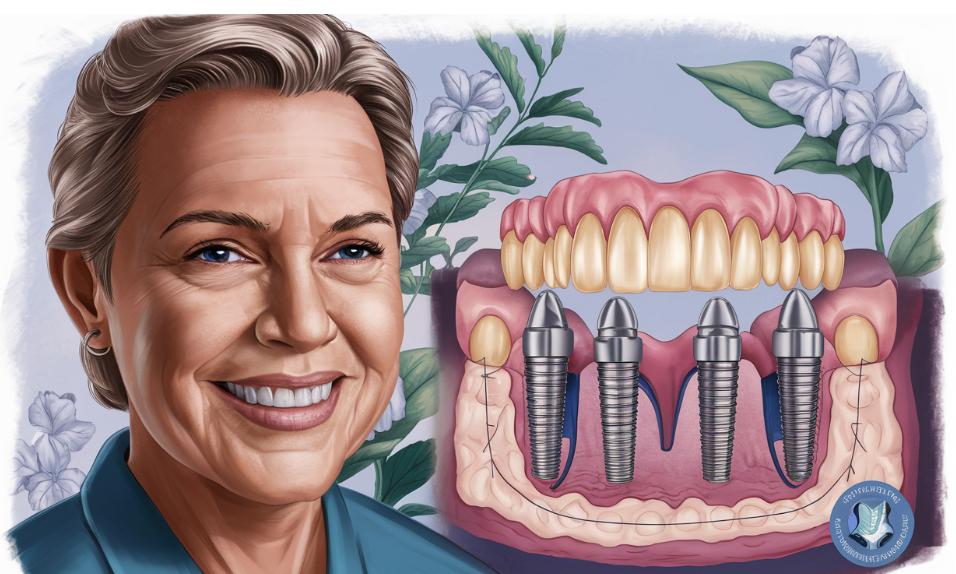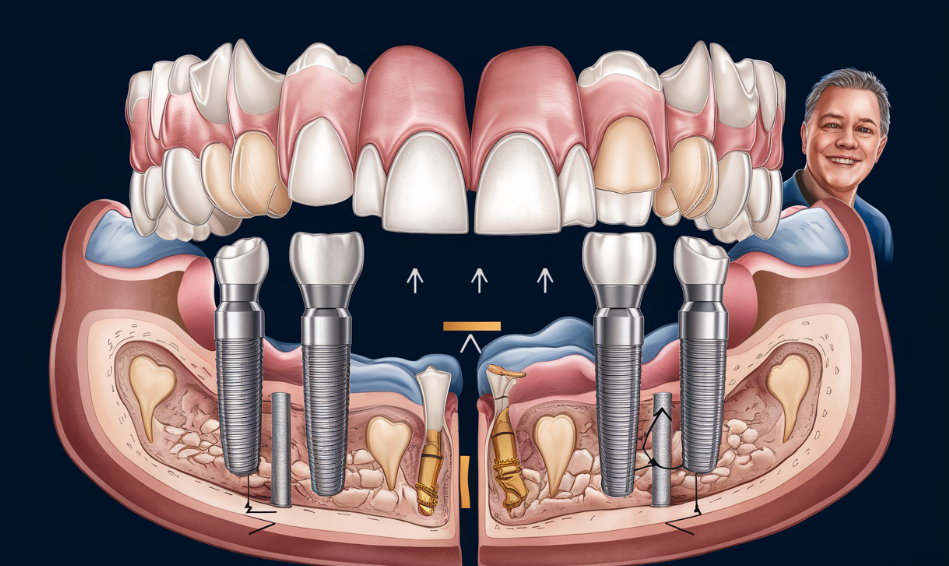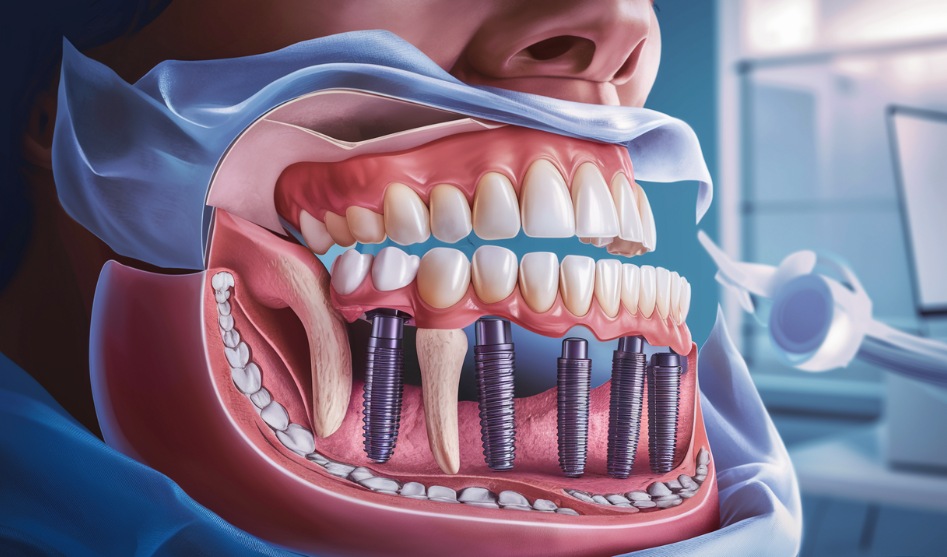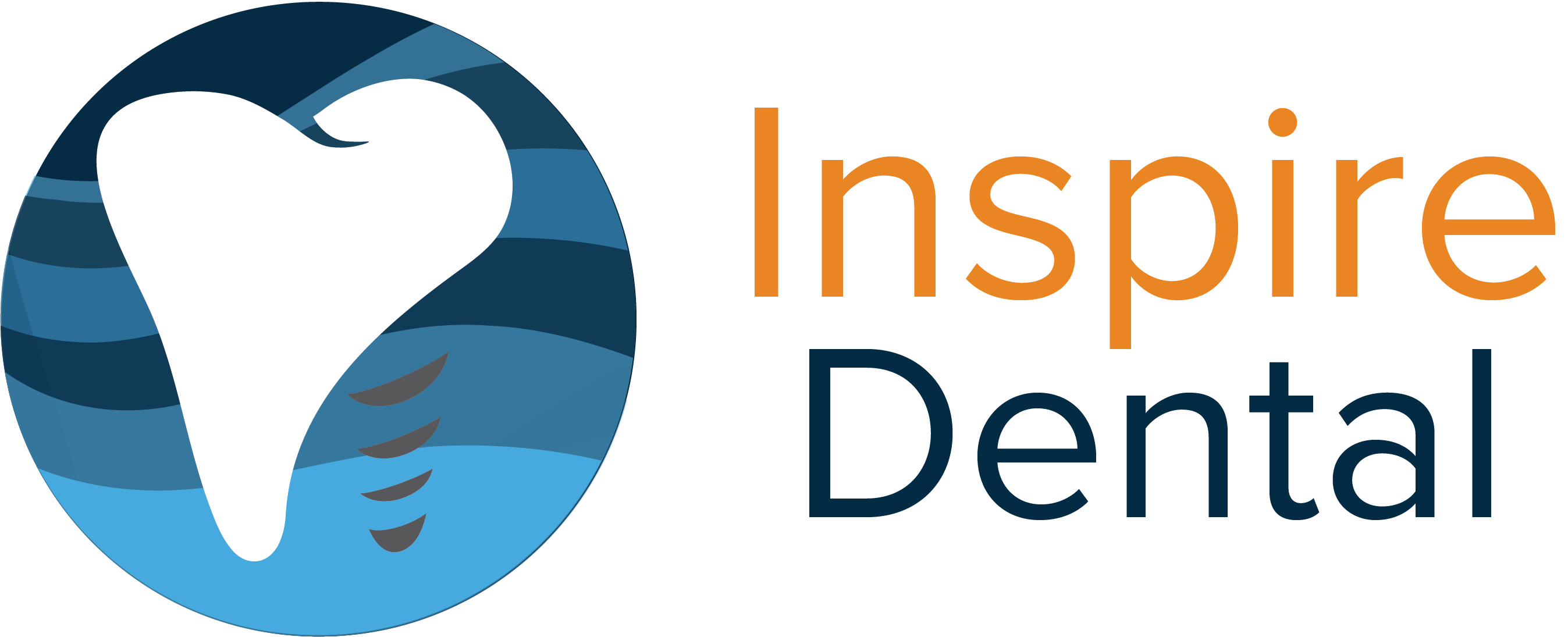The All-on-4 implant technique is a revolutionary dental procedure that offers a permanent solution for patients with multiple missing teeth or those who need full arch restoration. This innovative approach uses just four strategically placed dental implants to support a full arch of prosthetic teeth, providing a stable and long-lasting alternative to traditional dentures.
Key Takeaways
- All-on-4 implant technique uses four dental implants to support a full arch of teeth
- Provides a permanent solution for multiple missing teeth or full arch restoration
- Offers faster recovery and immediate functionality compared to traditional implants
- Suitable for patients with bone loss who may not qualify for standard implants
- Cost-effective long-term solution with improved quality of life
- Requires proper maintenance and regular dental check-ups for longevity
Understanding the All-on-4 Implant Technique
The All-on-4 implant technique is a dental restoration method that has gained popularity in recent years. It offers a fixed, permanent solution for patients who have lost all or most of their teeth in either the upper or lower jaw. This method is different from traditional dental implants because it uses only four implants to support an entire arch of teeth, rather than placing an implant for each missing tooth.

How All-on-4 Implants Work
The All-on-4 technique works by placing two straight implants in the front of the jaw and two angled implants in the back. This strategic placement allows for maximum support and stability of the prosthetic teeth. The angled rear implants help to avoid the sinus cavities in the upper jaw and the nerve canal in the lower jaw, making it possible for patients with bone loss to receive implants without needing bone grafting procedures.
Benefits of the All-on-4 Technique
One of the main advantages of the All-on-4 technique is that it provides immediate results. Patients can often receive their new teeth on the same day as their implant surgery. This is a significant improvement over traditional implant methods, which often require several months of healing before the final teeth can be placed.
Other benefits include:
- Improved appearance and self-confidence
- Better chewing function and speech
- Preservation of jawbone and facial structure
- No need for messy adhesives or removal for cleaning
- More comfortable than traditional dentures
Candidacy for All-on-4 Implants
Not everyone is a suitable candidate for the All-on-4 implant technique. However, this method can be an excellent option for many patients who might not qualify for traditional implants due to bone loss.
Ideal Candidates
The best candidates for All-on-4 implants are individuals who:
- Have lost most or all of their teeth in one or both jaws
- Are looking for a permanent solution to missing teeth
- Have sufficient bone density to support the implants
- Are in good overall health
- Do not smoke or are willing to quit for the duration of the treatment
Considerations for Patients with Bone Loss
One of the unique aspects of the All-on-4 technique is that it can often be used for patients with some degree of bone loss. The angled placement of the rear implants allows them to be anchored in areas with more bone density, reducing the need for bone grafting in many cases.

The All-on-4 Implant Procedure
The All-on-4 implant procedure is typically completed in several stages. While the exact process may vary depending on the individual patient’s needs, here’s a general overview of what to expect:
Initial Consultation and Planning
The first step in the All-on-4 process is a comprehensive consultation with a dentist or oral surgeon. During this appointment, the dental professional will:
- Examine your mouth and assess your oral health
- Take X-rays and 3D scans of your jaw
- Discuss your medical history and any medications you’re taking
- Explain the procedure and answer any questions you may have
Based on this information, they will create a personalized treatment plan for your All-on-4 procedure.
Preparation for Surgery
Before the surgery, you may need to:
- Stop taking certain medications as advised by your dentist
- Arrange for someone to drive you home after the procedure
- Fast for several hours before the surgery if you’ll be receiving IV sedation
The Surgical Procedure
The All-on-4 implant surgery typically takes place in a single day, often referred to as “Teeth in a Day.” Here’s what happens during the procedure:
- You’ll receive anesthesia to ensure your comfort during the surgery
- Any remaining damaged teeth will be extracted
- The jawbone will be prepared for the implants
- Four implants will be surgically placed in your jaw – two straight implants in the front and two angled implants in the back
- A temporary set of teeth will be attached to the implants
Recovery and Aftercare
After the surgery, you can expect some swelling and discomfort for a few days. Your dentist will provide instructions for care and may prescribe pain medication and antibiotics. You’ll need to follow a soft food diet for several weeks to allow the implants to heal and integrate with your jawbone.
Final Prosthesis Placement
After a healing period of about 3-6 months, you’ll return to have your permanent prosthetic teeth placed. These are custom-made to fit your mouth perfectly and provide a natural-looking smile.
Comparing All-on-4 to Traditional Implants
While both All-on-4 and traditional implants offer permanent solutions for missing teeth, there are some key differences between the two approaches:
| Aspect | All-on-4 Implants | Traditional Implants |
|---|---|---|
| Number of implants | 4 per arch | 6-8 per arch |
| Treatment time | Often completed in one day | Several months to a year |
| Bone grafting | Rarely needed | Often required |
| Immediate function | Yes | No |
| Cost | Generally lower | Often higher |
Maintenance and Long-Term Care
Proper maintenance is crucial for the longevity of your All-on-4 implants. Here are some tips for caring for your new teeth:
- Brush twice daily with a soft-bristled toothbrush
- Use a water flosser or interdental brushes to clean under and around the prosthesis
- Avoid biting on hard objects or using your teeth as tools
- Attend regular dental check-ups and professional cleanings
- Avoid smoking, as it can negatively impact implant healing and longevity
Cost Considerations for All-on-4 Implants
The cost of All-on-4 implants can vary widely depending on factors such as:
- Geographic location
- The dentist’s experience and expertise
- The materials used for the prosthetic teeth
- Any additional procedures needed (such as extractions)
While the upfront cost of All-on-4 implants may seem high, it’s important to consider the long-term value. Unlike traditional dentures that need to be replaced every few years, All-on-4 implants can last a lifetime with proper care, making them a cost-effective solution in the long run.
Potential Risks and Complications in All-on-4 Implant Technique
As with any surgical procedure, there are some risks associated with All-on-4 implants. These may include:
- Infection at the implant site
- Implant failure or rejection
- Nerve damage
- Sinus problems (for upper jaw implants)
- Damage to surrounding teeth or blood vessels
However, these risks are generally low when the procedure is performed by an experienced dental professional.

Patient Experiences with All-on-4 Implants
Many patients report high satisfaction with their All-on-4 implants. They often describe feeling as though they have their natural teeth back, with improved ability to eat, speak, and smile confidently. However, it’s important to note that there is an adjustment period as patients get used to their new teeth.
Choosing a Dentist for All-on-4 Implants
Selecting the right dentist for your All-on-4 procedure is crucial. Look for a dental professional who:
- Has specific training and experience in the All-on-4 technique
- Can provide before-and-after photos of previous patients
- Offers a comprehensive consultation and personalized treatment plan
- Uses advanced technology for planning and placement of implants
- Has positive patient reviews and testimonials
Alternatives to All-on-4 Implant Technique
While All-on-4 Implant Techniques are an excellent solution for many patients, they’re not the only option for full arch restoration. Other alternatives include:
- Traditional full-arch implants
- Implant-supported dentures
- Traditional dentures
Your dentist can help you determine which option is best for your specific needs and circumstances.
The Future of All-on-4 Implant Technique
As dental technology continues to advance, we can expect to see further improvements in the All-on-4 technique. This may include:
- More precise implant placement using advanced imaging and computer-guided surgery
- Improved materials for both implants and prosthetic teeth
- Faster healing times through the use of growth factors and other biological agents
These advancements could make the All-on-4 Implant Technique procedure even more accessible and successful for a wider range of patients.
Conclusion
The All-on-4 implant technique represents a significant advancement in dental implant technology. It offers a faster, less invasive, and often more affordable solution for full arch restoration compared to traditional implant methods. While it’s not suitable for everyone, for many patients, All-on-4 implants can provide a life-changing improvement in oral health, function, and quality of life.
If you’re considering All-on-4 Implant Technique, it’s essential to consult with a qualified dental professional who can assess your case and provide personalized recommendations. With proper care and maintenance, All-on-4 Implant Technique can provide a permanent, natural-looking solution for missing teeth, allowing you to eat, speak, and smile with confidence for years to come.
